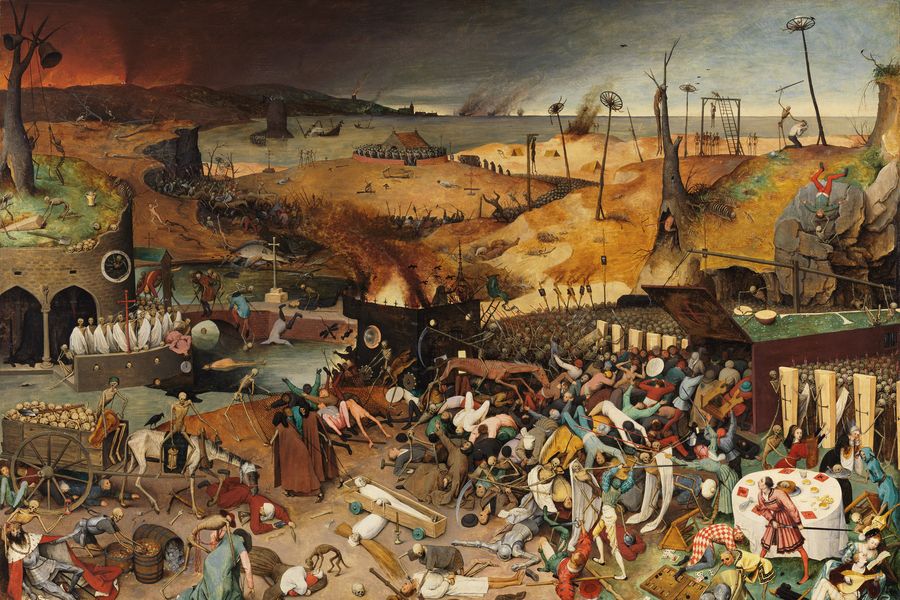Wallace Stevens wrote of dying as “absolute and without memorial.” This is Pieter Bruegel’s circa 1562 world-masterpiece painting The Triumph of Death, a panoramic pandemonium of an army of skeletons laying waste to a barren burning landscape while murdering every human being in sight. Lately, I have spent so much time contemplating this painting, I feel I have almost been living inside it. The painting hangs inside Madrid’s Prado Museum — for me, the greatest museum of Western painting on earth, and one whose collection is enthralling even from the distance of a keyboard.
No one gets out of this painting alive — except those already dead. From the left, a cart pulled by an emaciated horse and filled with a mountain of skulls is driven by a skeleton ringing a bell and holding an hourglass that has run out of sand. Directly above, a chorus of skeletons clad in Roman togas or mock angel robes throws a man into a moat; a bloated body floats by. Some in this group blow trumpets signaling this godless apocalypse. A skeleton sticks his head out of the face of a clock; midnight is nigh. Two skeletons nearby ring two large bells. They toll for us all.
In the distance, bodies hang from gallows and are tied to pikes, decapitated, pursued by hellhounds, thrown off cliffs, torn apart, and bound to Catherine or breaking wheels mounted at the top of tall poles. These were common sights to Bruegel.
About a decade before Bruegel was born near Breda, Martin Luther made his 95 Theses public, initiating the Reformation. By 1562, about when this painting was made, Catholic Spain controlled the territory and the Inquisition was in full cry. All suspected Protestants were summarily tortured and killed outright, placed on the very kind of wheels and gallows seen in the painting. Look closely and you’ll see bones beneath these devices. The Spanish forbade anyone to remove the bodies, which were left to rot or be consumed by carrion-eating birds and dogs. Bruegel knew brutal fear, human cruelty, and the terrible mirror of precarious life and mindless death. The curse is global and happening to everyone everywhere at once.
Even though he is among the greatest artists who ever lived, Bruegel has always been an odd man out of art history. Only about 40 paintings survive, along with numerous prints; his work sold well. Critics, art historians, and academics scoffed at it. To me, his Harvesters painting at the Met is the second-best yellow painting in art history, after only van Gogh; his jam-packed scenes and pictures of deeply human peasants can take many lifetimes to piece together. Modernism and academia had little use for his simple, roly-poly, awkward caricature-like world. Yet Bruegel’s work has a sweetness of life and one of the most gentle, loving, and nuanced touches in Western painting. Getting close to a Bruegel is like running your eyes through combed hay — rough, textured into infinity, every microdetail filled with energy. Bruegel isn’t complicated enough for most scholars. It turns out, however, that “not complicated” is medicine for our complex times. Bruegel communicates directly to the cerebral cortex. His work isn’t a palliative or any idea of “the beautiful.” Rather it is a confirmation of the fundamental structures of seeing, thinking, feeling, fearing, hoping, taking pleasure in the little comforts, and intuiting things bigger than all of us. Like viruses.
In my first uncertain days of self-isolation with my wife, who is in several very high-risk categories for the coronavirus, I didn’t tell her about keeping this painting within me. It was a secret garden. I was afraid I might not get the same view of this image with someone else “looking” at it with me. When I told her I was writing about this picture of no hope, no morality, only extinguishing catharsis that makes no sense and where there is no control, she understood this and said she’d been thinking of her own talismanic pictures too.
I would never ask her what her images are.
These strange days, I now spend time “being inside” of the Bruegel. None of what I see is depressing, scary, sad, or chilling. I don’t cower in fear or feel harrowed when I look at it. The painting is a grand, sort of gorgeous ocean that turns out to have always been there, even though I never knew it. These days, I bathe in its revelatory waters.
*This article appears in the March 30, 2020, issue of New York Magazine. Subscribe Now!





